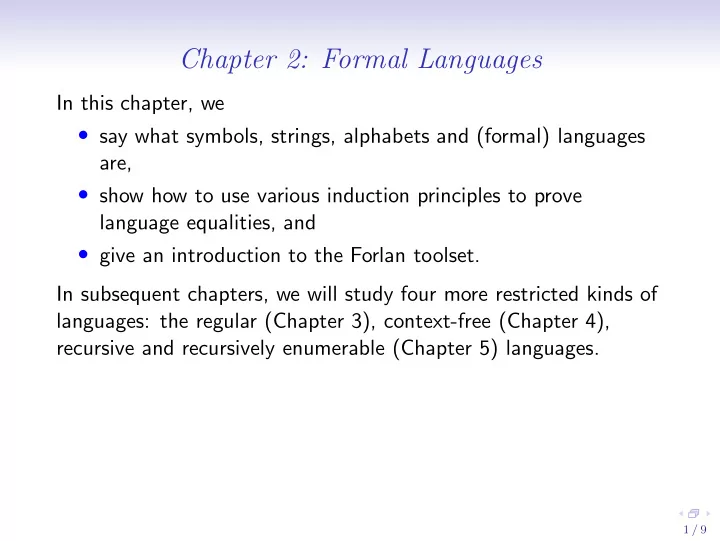

Chapter 2: Formal Languages In this chapter, we • say what symbols, strings, alphabets and (formal) languages are, • show how to use various induction principles to prove language equalities, and • give an introduction to the Forlan toolset. In subsequent chapters, we will study four more restricted kinds of languages: the regular (Chapter 3), context-free (Chapter 4), recursive and recursively enumerable (Chapter 5) languages. 1 / 9
2.1: Symbols, Strings, Alphabets and (Formal) Languages In this section, we define the basic notions of the subject: symbols, strings, alphabets and (formal) languages. 2 / 9
Symbols A symbol is one of the following finite sequences of ASCII characters: • One of the digits 0–9; • One of the upper case letters A–Z; • One of the lower case letters a–z; and • A � , followed by any finite sequence of digits, letters, commas, � and � , in which � and � are properly nested, followed by a � . For example, � id � and �� a , � b � are symbols. On the other hand, � a �� is not a symbol since � and � are not properly nested in a � . We write Sym for the set of all symbols. It is countably infinite. 3 / 9
Strings A string is a list of symbols. We typically abbreviate the empty string [ ] to %, and abbreviate [ a 1 , . . . , a n ] to a 1 · · · a n , when n ≥ 1. We write Str for List Sym , the set of all strings. It is countably infinite. Because strings are lists, we have that | x | is the length of a string x , and that x @ y is the concatenation of strings x and y . We typically abbreviate x @ y to xy . Concatenation is associative: for all x , y , z ∈ Str , ( xy ) z = x ( yz ) . % is the identify for concatenation: for all x ∈ Str , % x = x = x % . 4 / 9
Raising a String to a Power We define the string x n resulting from raising a string x to a power n ∈ N by recursion on n : x 0 = % , for all x ∈ Str ; x n +1 = xx n , for all x ∈ Str and n ∈ N . We assign this operation higher precedence than concatenation, so that xx n means x ( x n ) in the above definition. Proposition 2.1.1 For all x ∈ Str and n , m ∈ N , x n + m = x n x m . Proof. An easy mathematical induction on n . The string x and the natural number m can be fixed at the beginning of the proof. ✷ 5 / 9
Prefixes, Suffixes and Substrings Suppose x and y are strings. We say that: • x is a prefix of y iff y = xv for some v ∈ Str ; • x is a suffix of y iff y = ux for some u ∈ Str ; • x is a substring of y iff y = uxv for some u , v ∈ Str . A prefix, suffix or substring of a string other than the string itself is called proper . For example: • 12 is a proper prefix of 1234; • 234 is a proper suffix of 1234; • 23 is a proper substring of 1234. 6 / 9
Alphabets An alphabet is a finite subset of Sym . We use Σ to name alphabets. We write Alp for the set of all alphabets. Alp is countably infinite. We define alphabet ∈ Str → Alp by right recursion: alphabet % = ∅ ; alphabet ( ax ) = { a } ∪ alphabet x , for all a ∈ Sym and x ∈ Str . I.e., alphabet w consists of all of the symbols occurring in the string w . E.g., alphabet (01101) = { 0 , 1 } . If Σ is an alphabet, then we write Σ ∗ for List Σ. 7 / 9
Languages We say that L is a language iff L ⊆ Σ ∗ , for some Σ ∈ Alp . If Σ ∈ Alp , then we say that L is a Σ- language iff L ⊆ Σ ∗ . Here are some example languages (all are { 0 , 1 } -languages): • ∅ ; • { 0 , 1 } ∗ ; • { 010 , 1001 , 1101 } ; • { 0 n 1 n | n ∈ N } ; • { w ∈ { 0 , 1 } ∗ | w is a palindrome } . Every language is countable. Furthermore, Σ ∗ is countably infinite, as long as the alphabet Σ is nonempty. ( ∅ ∗ = { % } .) 8 / 9
Languages (Cont.) We write Lan for the set of all languages. It is uncountable: even P { 0 } ∗ , the set of all { 0 } -languages, has the same size as P N . Given a language L , we write alphabet L for the alphabet � { alphabet w | w ∈ L } . For all languages L , L ⊆ ( alphabet L ) ∗ . If A is an infinite subset of Sym (and so is not an alphabet), we allow ourselves to write A ∗ for List A . For example, Sym ∗ = Str . 9 / 9
Recommend
More recommend